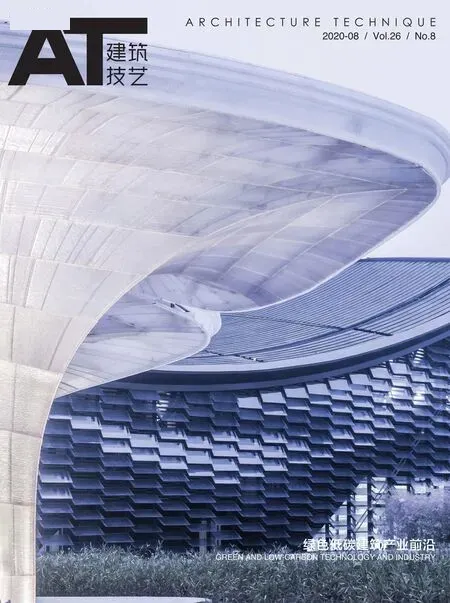形式、物质、流动
西班牙Abalos+Sentkiewicz AS+事务所
李明阳 LI Mingyang/ 译
王祥 WANG Xiang/ 校
作为建筑执业者,我们认为设计师不能只满足于追求建筑内部能量平衡的环境评估体系,因为其代价是将公共空间当作容纳建筑能量耗散的“垃圾箱”。与之相反,在借助参数化工具和基本热力学定律实现的建筑设计中,形式、物质、流动达成的平衡关系将有助于塑造真正的热力学建筑,它植根于地域性的物质文化并融入城市环境,而非仅仅“寄生”其中。本文将介绍Abalos+Sentkiewicz AS+事务所开发的有关建筑热力学的专业设计技术。
首先用一张阐释了我们设计理念的图来展开说明这个简短的宣言,如图1所示,上图由Foster+Partners事务所高级执行合伙人Stefan Behling于2002年创作,下图则是2013年Abalos+Sentkiewicz AS+事务所对其重新审视后绘制的新版本。Stefan Behling指出,现代建筑在人们的理解中就像“冰箱”一样,通过隔热层与外界气候变化完全隔绝,并借助机械设备人为地创造出持续稳定的室内气候。人们也理所当然地认为能源平衡问题仅限于建筑内部,对排放到街道等公共空间的废弃物置之不理。而Behling描绘的未来就是我们当下面临的问题:建筑的形式成为实现能量平衡的关键。针对特定气候参数适当地调整设计方案以达到形式、物质、能源流动之间的协调,将使得我们可以最大程度地减少建筑物中主动式能量控制系统的使用。这一思想并不新鲜,在以往许多建筑中,适应气候的设计策略已经成为一种普遍现象。因此,我们在Behling的图中增加了名为“过去”的三角形,以弥补对本土建筑认知的缺失。建筑师可以从传统建筑中学到很多,这种学习绝非照搬原样,而是理解它们的原理并通过现代技术和材料来重新应用,诸如参数化软件之类的工具能帮助我们以一种与静态思维相反的动态方式来应对气候问题。
研究表明,人们更喜欢具有“热力学肌理”的空间,即一种具有非对称热力学参数并且在合理范围内变动的空间。这种偏好还与建筑使用者的健康以及身心舒适有关。因此,这里要强调的是我们从来不单独讨论热力学,而是同时关注建筑学、热力学和美学这三者的结合统一。
下文中将通过三个具体的实践案例来研究三种不同规模和气候条件下的建筑类型。虽然这三个原型是针对特定使用情况开发的,但由于它们的设计重点是定义外部气候与人体之间的“接口”,因此也适用于其他项目。我们的做法是定义适合使用者身体舒适度的空间,或提供庇护或使他们置身特定的四季气候环境中。
第一个原型是适用于潮湿的亚热带气候的庭院类型,它采用窄开间布局,有利于必要的自然通风,基于对气流组织的关注,这种类型界定了用以提升舒适感的外部空间。第二个原型是适用于寒冷干燥的草原气候的立方体类型,与前者不同的是,它结构紧凑,最大程度地减少了与室外的换热面积,使室内免受大温差的影响。第三个原型是适用于温和的地中海气候的“轻型棚屋”或厂房类型,它能为室外和室内空间提供不同的日照条件和良好的通风条件,具有持久的舒适性。
第一个原型的开发侧重于界定一种装置,我们可称之为“人造树”,这种装置可以控制空气和水的流通以调节庭院环境。第二个原型则优先考虑贯穿内部空间的结构体系升级,使这些空间具有维持在人体舒适度范围内的热稳定性。值得一提的是,这个案例中使用者提出了特殊的湿热要求(用来满足艺术品收藏的严格条件),这使我们能够以极高的精度对设计进行微调。这种立方体原型的适用范围还可以拓展到其他有严格环境要求的情况(如实验室、档案馆、图书馆等)。最后一个案例中对空间灵活性和多样性的探索占据主导,我们试图寻求一种适应性,使建筑能够随着时间推移满足各种娱乐活动的需求,其中包括了静态和动态的空间,以及私密空间和集体活动空间。
1 珠海当代艺术博物馆(中国珠海,2003-)
珠海当代艺术博物馆是在国际竞赛中获得一等奖的设计作品(图2)。该项目位于中国南部的珠江三角洲,毗邻澳门岛,距香港60km。因为世界上最长的港珠澳大桥从这里架起,使得这一项目成为海湾沿岸的一个特殊地块。我们的项目研究从对当地气候的分析开始——Koppen-Geiger气候分类系统显示该地处于潮湿的亚热带气候区,具有稳定的温度和极高的湿度。此外,任务书中还包括一个三层的地下停车场,也是设计方案必须回应的一点。因此,方案设计的第一步是考虑如何有效地利用停车场的混凝土外墙的热稳定性并使其惠及上部楼层。这一步设计先是由停车场平面直接生成形体,然后在形体上打开不同的孔洞。在这些孔洞中最重要的是通过内部“挖空”所形成的中央庭院组织对流通风,使中庭成为建筑应对高湿气候的关键。
下一步是根据建筑与阳光的关系对屋顶曲线进行处理,以借助辐射来减少屋顶湿度,并通过夜间散热将热量传递到大气中,这种方法可以在晚上对建筑物进行热重置。此外,建筑物的所有外窗均设计为狭长的竖条状,既满足了预期的展览功能中避免阳光直射的需要,也为室内提供了对流通风。这些设计操作塑造了两个公共空间:高低起伏的屋顶广场以及可以进行展览等户外活动的有遮蔽的庭院(图3)。前者利用起伏的屋顶形成了一系列相互连通的露天剧场,作为眺望城市及其周边地区的公共看台;后者则为庭院置入了避雨遮阳的防护措施,成为该项目最独特的亮点之一。
用于避雨和遮阳的凉棚或“保护伞”的设计基于两个基本概念:雨水的收集利用以及整体起伏屋顶形成的视觉连贯性。该系统的灵感来自对龙血树(Dracaena Cinnabari)的研究,龙血树的其独特之处在于,除了能提供宽阔的阴影外,还能利用树冠从大气中吸收水分并通过复杂的分支系统分配水分,而不像绝大多数树木通过根茎从土壤中吸收水分。基于这一原理,我们设置了六棵人造树(图4),它们不仅像真正的龙血树一样可以收集和分配雨水,还具有调节屋顶广场气流的作用。

1 热力学建筑中平衡关系的设计理念
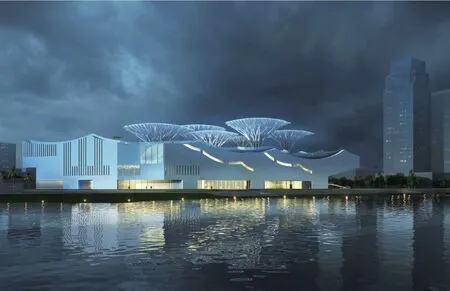
2 珠海当代艺术博物馆对岸海湾视角
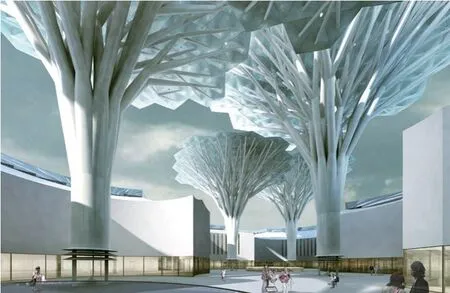
3 珠海当代艺术博物馆中央庭院
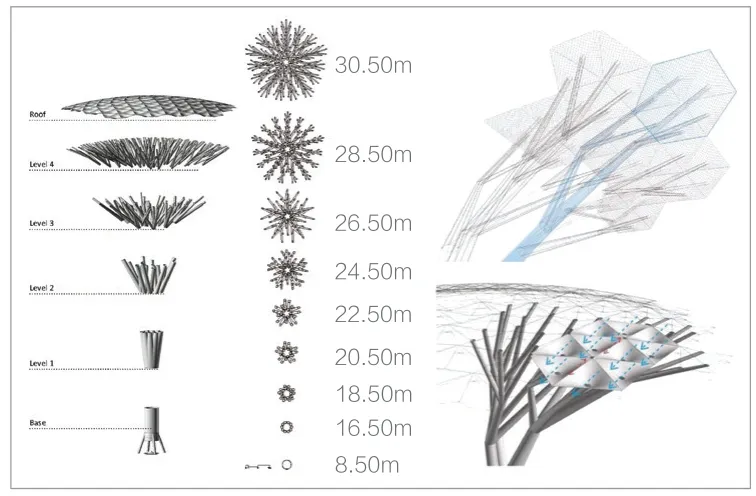
4 珠海当代艺术博物馆珠海热力人造树
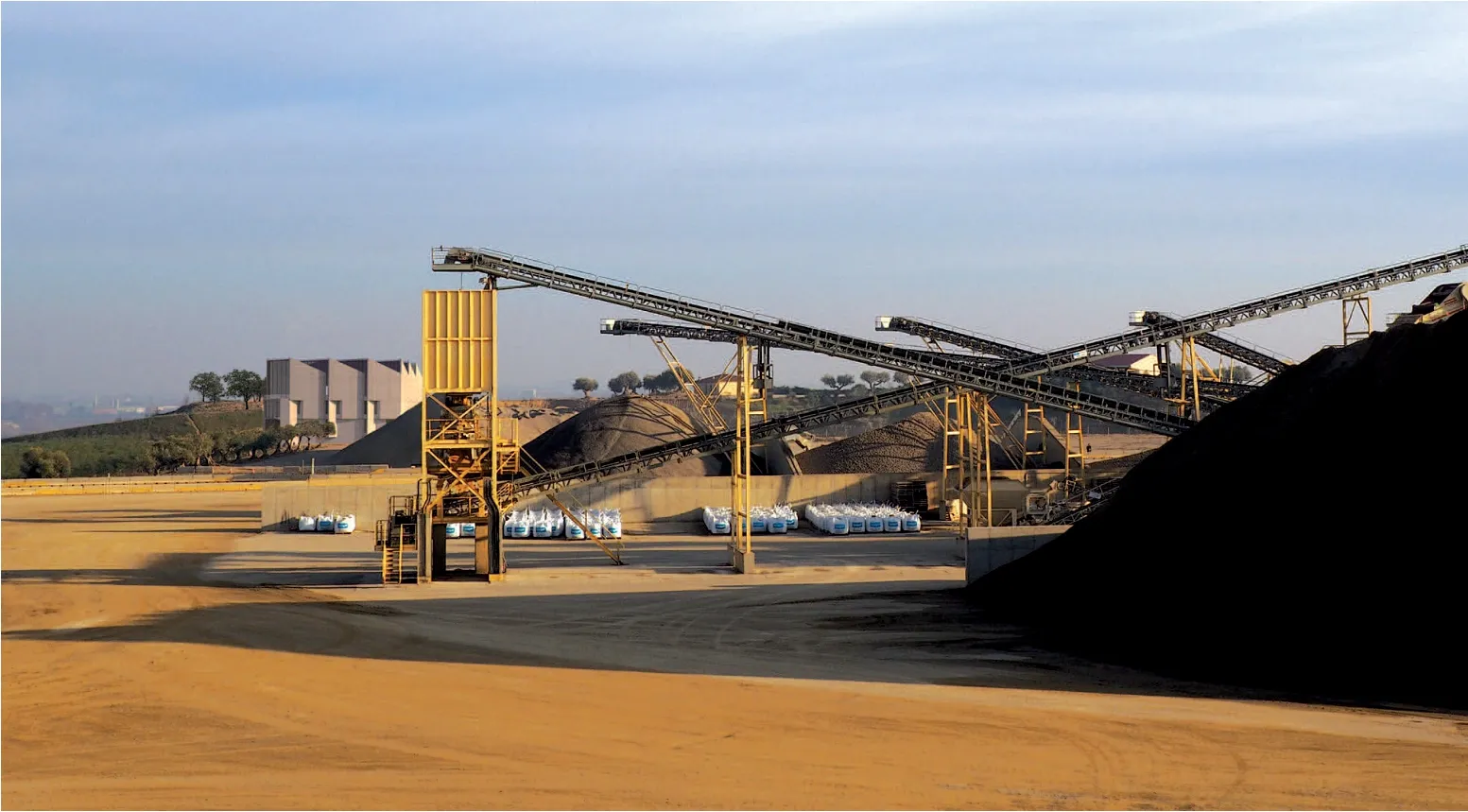
5 Sorigué 基金会采石场
参与人造树研发的工程师Salmaan Craig定义了两种空气流通机制:下行模式和上行模式。下行模式是在早上将凉爽的空气引入庭院,而上行模式则是在下午将高温空气排出。具体来说,在夜间不锈钢人造树的温度会下降,第二天早上空气接触其表面后被冷却,而后通过循环管道网络引入庭院中,同时晨露蒸发也有利于降温。而到了下午某一时刻,随着钢材在日照下逐渐升温,这种下行模式会被上行模式取代,空气流动的方向随之反转——人造树内部的空气被加热后通过树木内部管道向上流动被排出。
为了确保空气流通机制的正常运行,我们通过精确的几何规律确定了这些人造树的形状,其底部大开口确保了上行或下行气流的通畅。从独立主干开始的一系列分流总共形成了180个分支,这些分支的设计都遵循同一个原则:每一级分支的管道截面积之和必须保持恒定,以保证气流平稳。这种做法的另一个好处是使管道内部具有较大的相对表面积,这意味着结构本身就能发挥热交换器的作用来调节管道内部及其周围空气的温度。建筑整体则面向海湾呈现出富有张力和识别性的形象,作为从香港方向经港珠澳大桥驱车而来的人们进入珠海的门户,昭示着这座文化设施背后的宏大蓝图和战略眼光。
2 Sorigué基金会采石场(西班牙莱里达省巴拉格尔,2016-)
Sorigué基金会采石场项目中,建筑被赋予了当代重要艺术品收藏的功能(图5)。项目场地位于一个砾石坑中,在这里我们面对的是寒冷的半干旱草原气候(BSk)。与前一个案例相比,这个案例中最显著的气候特征不是湿度而是温差,因此精确的热力涨落图表成为我们推导项目设计方法的关键。如图6所示,该图收集了白天(红色)和夜间(蓝色)月平均温度的变化曲线,以及人体热舒适区域(黄色)的变化曲线。根据这些曲线我们可以清楚地认识到,与人体几乎恒定的热舒适需求相比,极端的温度波动已经说明了热稳定性作为项目出发点的重要性。而该项目场地的土层常年保持约14℃(黑色曲线),因此我们决定利用土层的高热惰性来解决温差问题。
通过对热稳定的探求,我们收获了开展设计的重要线索。一方面,建筑的体形系数必须是最佳的。因此我们提出了一种紧凑嵌入土壤的立方体作为建筑的基本原型,从而更好地利用土层的热稳定性。另一方面,我们根据朝向确定了屋顶形式,它的北侧开敞,南向则是封闭的,这样使得建筑避免了南向的直射阳光,从而满足保存艺术品的需要。随后,我们将这种屋顶形式转移到了建筑立面上,通过将建筑旋转45°并将所有窗户都向北敞开,实现了最大程度的间接采光。
然而,建筑的热稳定性需要高热惰性的材料才能实现,这些材料不仅要用于外部覆层,还要用于内部空间,特别是结构框架上。因此我们决定采用钢筋混凝土楼板和墙体,以生成所有内部空间并提供均一温度的连续结构。通过这样的设计,由大量混凝土建成的建筑体现出高度的一体性,其结构和装饰已然融合成为了一种建筑元素。
我们分析气候条件的另一个关键工具是一系列精心绘制的焓湿图(图7)。其中每组由四张图表组成,涵盖了一年中四个季节的温湿变化。图中的每一点代表一年中某一天的温度和湿度,而“舒适区”则代表人体舒适的环境区间(蓝色区域)。
第一组图表现了莱里达当地的气候条件,我们可以很清晰地观察到四个季节中温度的巨大变化及其与人体舒适温度的显著差距。第二组图则表示了建筑在进行技术升级之前的室内气候条件,验证了基于前文所述的形式、物质以及流动概念的建筑决策。我们可以观察到,在不采取其他措施的情况下,春秋两季有大量的点处于舒适区范围内,而夏冬两季则要通过额外的系统介入来调整与舒适区差异较大的极端温度。因此,我们决定对钢筋混凝土结构进行改进,即在楼板和墙体中预留管道来传导空气,使混凝土结构形成一个连续的管道系统(也被称为“加拿大管网”),即将经过恒温土层过滤和调温的空气导入室内,而不是直接从室外引入空气。为此,我们设计了一长条地下管线使外部空气与土壤可以进行充分的热交换。最后一组图表显示了利用上述系统对建筑进行优化后的结果。从中可以看到,夏季室内的高温问题已经解决,而冬季室内温度则略低于舒适标准(主要是由于土层温度仅为14℃)。在这种情况下,我们认为这样的结果是令人满意的,在敦促游客穿着用以保暖的衣服(如毛衣或轻便外套)的同时,也完全满足了其他“使用者”(艺术品)的收藏保护要求。为了进一步达到通用的热舒适标准,即保证冬天室内温度达到21℃左右,我们也必须采用一些主动式系统。为此我们提出了使用辐射地板采暖系统(图8),其与使用者的关系更加紧密,也保证了一年中任何时间的室内舒适度。
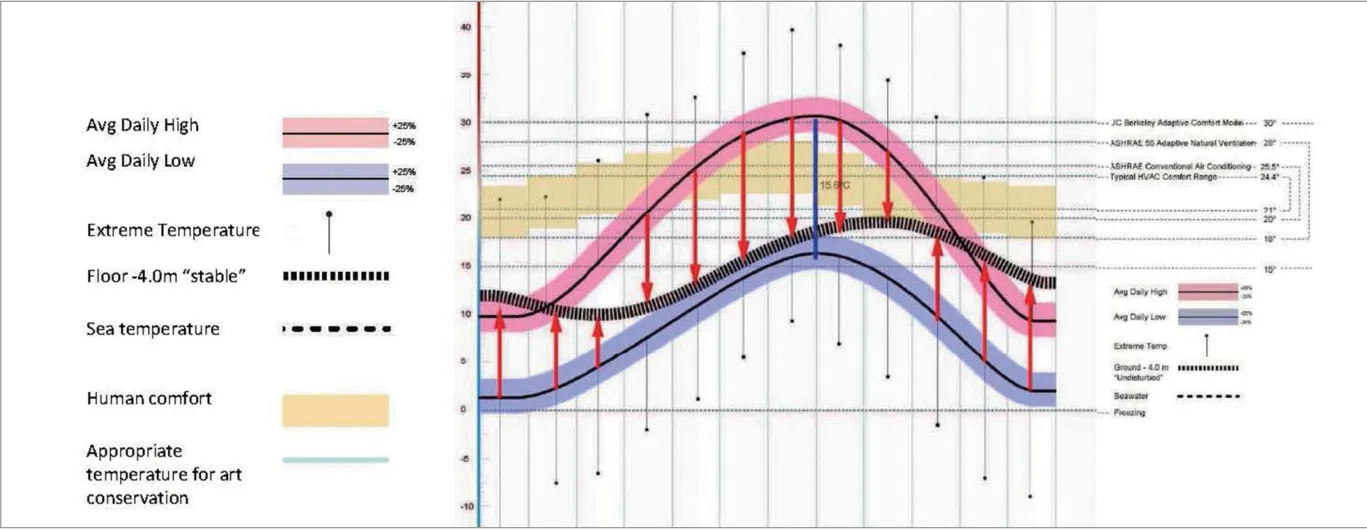
6 Sorigué 基金会采石场全年热力波动涨落图

7 Sorigué 基金会采石场气候焓湿图
经过土层调温的空气在建筑物内的流通遵循两种机制:对于用作展览的4m高空间,空气从天花板处引入。在后者这些较高的空间内,大量人群的人体热辐射和投影仪之类的机器散热将产生热量聚集,而相对更加高大的空间尺度则可以使这些积聚的热量远离人群。同时,建筑顶层采用锯齿状天窗(图9)促进夏季天花板处积聚空气的排出,并利用贯穿所有楼层的中庭空间为整个室内提供通风,中庭的烟囱效应也可以在夜间对建筑进行热重置。
综上所述,我们把这个用作艺术品收藏和展览的容器理解为第二种热力学建筑的原型。设计中采用的穿孔混凝土框架体系使用了从砾石坑中开采的原材料作为混凝土骨料,这种建造系统具有很高的灵活性,这也使得该原型能够适用于其他项目。

8 Sorigué 基金会采石场热力学分析截面

9 Sorigué 基金会采石场Planta 顶层内部视图

10 西班牙Azuqueca de Henares 休闲中心南立面视图

11 西班牙Azuqueca de Henares 休闲中心室内房间景观
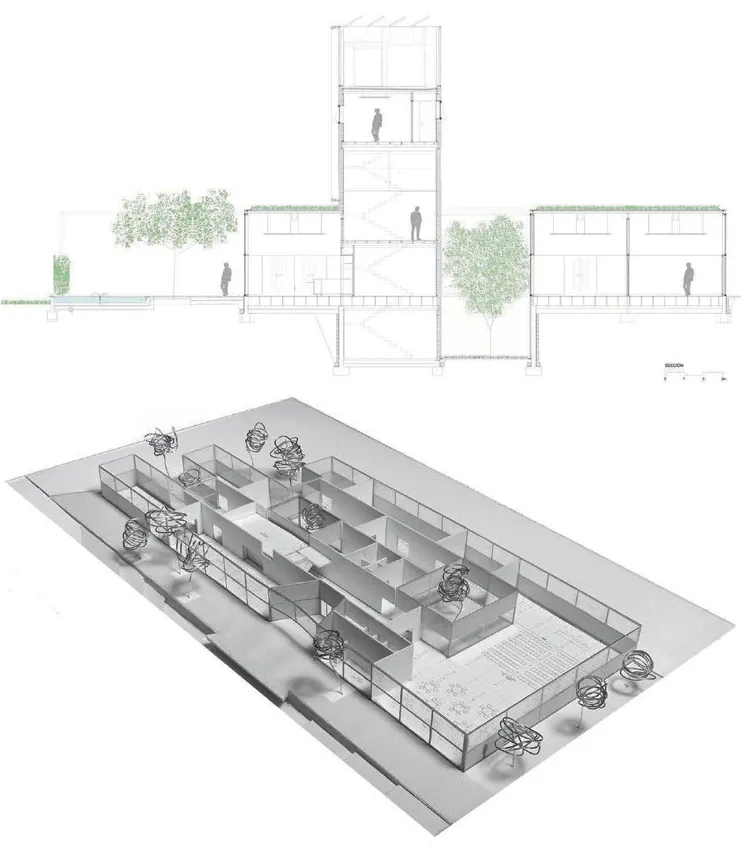
12 西班牙Azuqueca de Henares 休闲中心剖面和模型
3 西班牙Azuqueca de Henares休闲中心(西班牙瓜达拉哈拉省,2007—2011)
西班牙Azuqueca de Henares休闲中心同样位于西班牙(图10),但其所处气候环境与前两个案例完全不同,属于温和的地中海气候(Csa)。每年有大约8个月都保持在热舒适范围内。该项目位于距马德里100km的一个工业小镇,我们在早期通过概念方案的竞标获得了最终设计权。休闲中心的功能设定相对自由,包括计算机室、图书馆、礼堂等。
项目功能的开放定义以及其坐落城镇所有的工业建筑特性(后者对项目有重要影响力),促使我们能够在首层采用一种延展性的单层建筑建造体系。建筑内部由无走廊连接的房间组成(图11),在平面布局上,这些房间构成了一个虚实空间相互交错的矩阵,产生了丰富的效果(内外渗透、不同的方位朝向、尺度和光影等),进而塑造了不同的内部环境,也提供了空间的多种用途。方案设计中包含了一系列相互平行的内部庭院,这也是对当地传统建筑类型La Manch(当地的带露台房屋)中热力学原理的沿用。功能布置则从朝向出发:南向主要布置相对安静的功能,因为在这些空间里使用者主要是就坐的状态,可以享受良好的采光;北向则布置一些最为活跃的功能(例如健身房)。
尽管该建筑主要为单层延展的模式,我们仍然保证了其内部4.20m的充足高度(图12),这是为了让积聚的热空气始终保持在人体高度之上。设计采取的其他被动式策略还包括通过露台进行自然通风以及设置宽敞的绿化屋顶。由于屋顶可以从周围的建筑中被清晰地看到,在设计中也被视为建筑的第五立面进行展示。值得一提的是,这类绿色屋顶在干燥状态下具有很好的隔热能力,因此在地中海气候区几乎没有降雨的夏季,它能避免建筑受到过多的太阳辐射。建筑的南立面完全由玻璃组成,在冬天被用作大型太阳能暖房,夏天则利用遮阳设施防止内部空间过热。在建筑南侧,我们还设置了两个重要的景观元素,也是地中海传统建筑的关键要素:通过绝热冷却在夏天发挥降温作用的水池和一系列精心种植的落叶树。它们在夏季可以遮阳,而冬季落叶后能使太阳辐射进入室内。
This paper explains the professional design techniques developed at Abalos+Sentkiewicz regarding thermodynamics in architecture.As practitioners,we cannot be satisfied with environmental assessments systems that only consider the interior energy balance of buildings as its goal at the expense of using public space as an energy dissipation dumpster.The balanced relationship between Form/ Matter/ Flow in architectural design -achieved by both parametric tools and basic thermodynamic principlescan contribute to a genuine thermodynamic architecture rooted in local material culture and tuned with the urban environment instead of parasitizing it.
I will extend this short manifesto in a couple of diagrams (fig.1) that define our design philosophy.The upper one was created by the Foster+Partners Senior Executive Partner Stefan Behling in 2002 and the lower one is a review carried out by Abalos+Sentkiewicz in 2013.Stefan Behling states that,during Modernity,the architectural form had a minimal impact on the energy balance.The modern building was understood as a kind of ‘refrigerator’ completely isolated from the climate and its variations through various layers of insulation,while inside that building an artificial,static and continuous climate was recreated by mechanical means.This also supposed that the energy balance concerns ended at the very limits of the building,expelling all toxins to the street or public space.
What Behling proposes as a future horizon is for us the present:architectural form is the key to the energy balance.The coordination between form,matter and flow,properly tuned for the parameters of a specific climate,allows us to minimize active energy control systems in buildings.This is not new.Adaptation to the climate is a well-known phenomenon in many architectures of the past.For this reason,we add to the Behling diagram a third triangle entitled ‘past’,in allusion to the lost knowledge of vernacular architecture.As architects,we have a lot to learn from these traditional architectures.Not to copy them directly,but to understand their principles and be able to apply them through contemporary techniques and materials,such as,for example,parametric software.This kind of tools helps us to operate with the climate in a dynamic way opposite to the static understanding of Modernity.When usually show a series of references of historical architectures associated with some images of thermal machines,what we mean is that our architecture is located right in the middle of them,working at the same time with both resources,History of Architecture and technology.
Studies show that people prefer ‘thermally textured’spaces where thermal parameters,within reasonable limits,are asymmetric and changeable.This preference is also related to health and physical and psychological well-being of architecture users.I would like to highlight that we never talk about thermodynamics,but about architecture,thermodynamics and beauty at the same time.
We are going to study,by means of particular examples of our practice,three building types with different scales and climatic conditions.These three prototypes have been developed for certain uses,but could be adapted to other programs,since their design is focused on defining,above all,an 'interface' between the external climate and the human body.Our practice defines spaces adapted to user’s bodies,protecting them or exposing them to specific conditions of climate and its variations throughout the year.In the first place,the courtyard type has been applied to a humid subtropical climate,adopting narrow bays that facilitate the necessary natural ventilation.Focused on managing air flows,this type defines an exterior space conditioned for human comfort.In the second place,the cube type has been applied to a cold,dry steppe climate.Unlike the previous one,it is compact and protects its interior from large temperature differences reducing to maximum the exchange surface with the exterior.Finally,the extensive or ‘lightweight shed’ (factory) type,used in a warm Mediterranean climate with a long period of human comfort,manages climate resources by defining exterior and interior rooms with different exposure to the sun and generous volumes of air.
The development of the first prototype focuses on the definition of devices or "artificial trees" that manage air and water flows to condition the courtyard.The second case prioritizes the development of an internal skeleton that crosses all spaces,providing them with thermal stability within the limits of human comfort.In this case,it is relevant to mention that the hygrothermal needs of a different user,an art collection with strict conservation conditions,led us to fine-tuning the design with great precision.This prototype of cube-type could also contain other demanding programs,such as laboratories,archives,libraries,etc.In the third and last case study,a Leisure Center (Factory type),the search for flexibility and variety of spaces has prevailed,seeking for adaptation over time to different recreational activities,static and dynamic,collective or individual.
Zhuhai Contemporary Art Museum.Zhuhai,China.2013-
The Zhuhai Museum of Contemporary Art (fig.2) is the result of a first prize awarded entry in an international competition.Located in the south of China,in the Pearl River delta,the project settled in a privileged plot on the bay shore,next to the island of Macao and 60 km away from Hong Kong.From this same point,the longest bridge in the world starts,connecting Zhuhai,Hong Kong and Macao.When we study a new project,we always start from the analysis of the local climate.The Koppen-Geiger climate classification indicates that we are in a humid subtropical climate (Cwa) with stable temperatures and extreme humidity.The tender statement included the project of a three-storey underground carpark that had to be respected by the proposal.The first operation of the project uses this concrete shell of the car park as an opportunity to use its thermal stability and take it to the upper levels above.This operation starts with the almost direct extrusion of the carpark footprint.Then,this volume is drilled by diverse openings.The most important of them is the central courtyard of the building that is ‘hollowed out’ inside.The courtyard is the key piece to combat high humidity by allowing cross ventilation around the central void.
The next step articulates the roof based on curves that interact with the sun,using radiation to reduce the humidity of the roof,as well as to transfer heat to the atmosphere by night irradiation,a method that allows us to thermally reset the building at night.All the exterior windows of the building are shaped as narrow vertical strips preventing the incidence of direct solar radiation,undesirable for the intended exhibition use,at the same time as allowing cross ventilation.With these design operations,two public spaces are generated:a topographic plaza on the rooftop and a covered courtyard (fig.3) capable of hosting exhibitions and outdoor uses.The first one uses the waves from the roof to shape a succession of concatenated amphitheaters.The result is a public observatory of the city of Zhuhai and its surroundings.On the other hand,the exterior space of the patio follows a protection strategy against rain and solar radiation that will be one of the most unique features of the project.
The design of pergolas or ‘umbrellas’ for shading and sun protection started from two basic ideas:the capture of rainwater for the use of the building,and the visual continuation of the topography of the roof by virtually completing the spatial unity of the whole.The form of this system is inspired by the study of the dracaena cinnabari or "dragon's blood tree" whose peculiarity lies in the fact that -in addition to providing a generous shade-it does not collect water from the underground with its roots,as most trees do,but it absorbs moisture from atmospheric air through its top and distributes it through the sophisticated geometry of its branches.In this way,six artificial trees inspired by the dragon tree are proposed (fig.4),which not only collect and distribute rainwater,similar to its organic predecessor,but also are used to manage the air flows in the patio.
The engineer Salmaan Craig collaborated in the development of these trees defining two flow functioning regimes:flow down (descending) and flow up (ascending).Down-draft brings the cool air to the courtyard in the morning and up-draft take up the hot air in the afternoon.The temperature of the stainless-steel mass of the tree drops during the night and when the morning comes it cools the air in contact with its surface making it descend into the courtyard through the interior of its network of circular tubes.Also,the humidity of the morning dew begins to evaporate with the first sun rays,contributing to the drop-in air temperature around it.This flow down strategy is substituted,at a point of the afternoon,by a flow up operation as the mass of the tree is heated by the sun.At this moment,the operation of the air flow is reversed:the air inside the tree is heated through its mass and starts to be expelled up through the trees.
To allow its correct operation,the shape of the trees has been carefully established by very precise geometric laws.At their base,they have a large opening that allows upward and downward flow.Starting from a single trunk,a series of bifurcations are made up to a higher level of 180 branches.The design principle of this structure dictates that the sum of the areas of the tube sections must be constant in order to maintain a homogeneous air flow.One of the effects of this design is a very high surface ratio versus the volume of air contained.This means that the tree itself functions as a heat exchanger that tempers the temperature of the air inside and around it.
The whole shows a powerful and recognizable image from the bay,necessary to give visibility to a cultural program of great ambition and strategic interest,being the gateway to Zhuhai for drivers who cross the bridge from Hong Kong.
PLANTA Project for Sorigue foundation.Balaguer,Lleida,Spain.2016-
Located in a gravel pit (fig.5) in a completely different climate and location,a building is commissioned to contain an important collection of contemporary art.In this case,we dealt with a cold,semi-arid steppe climate(BSk).Compared to the previous case study,in this case,the most significant feature of this climate is not humidity but rather high temperature contrasts.The elaboration of an accurate diagram of thermal oscillations has been key to define the design approach of our project.This diagram collects the variation curves of the monthly average temperature during the day (red) and night (blue) as well as the human thermal comfort area (yellow).At first glance,we can recognize that the extreme oscillation of temperatures,compared to the almost constant demands of human users,already indicates the importance of the search for thermal stability as a crucial project resource.For this reason,we have resorted to the high thermal inertia of the terrain (black curve),which maintains a temperature of around 14 degrees throughout the year (fig.6).
The search for stability already gives us important clues about design.On one hand,the form factor of the building,the relation between contained volume and exchange surface,must be optimal.Therefore,a compact form is proposed -a cube-which,to make use of the thermal stability of the soil,is embedded into the ground.On the other hand,the roof is shaped according to the solar orientations,opening us to the north and closing us to the south.In this way,we achieve adequate protection against direct solar radiation (necessary for the conservation of works of art).Later,we transferred this deformation of the roof to the facades,rotating the building 45 degrees in order to achieve the maximum indirect natural lighting from the north orientation,to which all the windows of the building open.
Seeking stability at the building demands a material of great inertia.Not only for the exterior cladding but especially for the interior structural skeleton.We decided to work with reinforced concrete slabs and walls,generating a continuous structure that runs through all the interior spaces and provides them with a uniform temperature.The result is a monolithic building where extensive use is made of concrete and where structure and finish are one and the same architectural element.
Another key tool for the analysis of climatic conditions is the elaboration of diverse series of psychrometric charts (fig.7).Each series is made up of four diagrams,one per season of the year,in which the points represent the temperature and humidity of every day of the year and the so-called ‘comfort zone’ represents the environmental limits of human well-being (blue area).
The first series represents the local climate of Lleida.The enormous variation between temperatures and its significant distance to comfort parameters can be easily observed.The second series represents the interior conditions of the building before its technical development,testing the architectural decisions of the aforementioned concepts of form,matter and flow.A considerable grouping of the points representing the daily temperatures is observed,guaranteeing comfort in spring and autumn,without using other means.Finally,another series of systems come on the scene to raise and lower the extreme temperatures of winter and summer that are still far from comfort standards.For this reason,it was decided to temper the reinforced concrete structural shell with air conducted through cloistered pipes inside slabs and walls.The concrete skeleton thus constitutes a continuous system of ducts through which air circulates not introduced directly from the outside,but filtered and tempered by the stabilizing action of the terrain.To do this we designed a long underground route so that the outside air exchanges heat with the soil.Then,a last series of diagrams shows the result of the building optimized by the incorporation of this so-called “Canadian tubes” system.In summer,the problems of high indoor temperatures have disappeared,while in winter the temperatures are slightly below comfort standards (remember that the temperature of the terrain is around 14°C).In this case,we could consider these results to be satisfactory,appealing that the visitor would have to wear some kind of warm clothing(as a sweater or light coat).Likewise,the art collection conservation environmental requirements,the ‘other’ user of our building,are already fully satisfied.To reach these mentioned conditions to the common standard comfort levels,that is,an interior temperature of around 21°C in winter,we have to implement some active systems.We proposed a radiant floor heating system,acting on a plane closer to the user for allowing us to guarantee interior comfort twelve months a year (fig.8).
The diffusion of the filtered and tempered air inside the building follows two schemes.For spaces 4 meters high,generally intended for exhibition uses,the air is blown down from the ceiling,while in spaces with higher heights it is blown up from below.These taller spaces are meant to have thermal gains by radiation from human bodies (greater audience attendance) and/or by machines such as video projectors,so that the greater height allows the accumulation of hot air away from user’s comfort zone.Likewise,on the upper floor,the sawtooth skylights(fig.9) enhance the evacuation of the air accumulated at the ceiling in the summer months,allowing ventilation of the entire interior by means of a vertical communication core that crosses all the floors of the building and is capable of function as a night time buoyancy chimney that thermally resets the building.
We understand the building as a thermodynamic prototype,used here as a container for an art collection and its exhibition.However,this container could be adapted to many other programs thanks to the great flexibility of its construction system based on a perforated concrete skeleton that uses local aggregates extracted from the same gravel pit where it is inserted as its main raw material.
Leisure Center.Azuqueca de Henares,Guadalajara,Spain.2007-2011
The third case study,also located in Spain,presents,however,a totally different climate from the previous two:what we can describe as warm Mediterranean (Csa).Much more benevolent than the other climates previously mentioned,the Mediterranean climate maintains comfort conditions around eight months a year.
The project (fig.10),located in Azuqueca de Henares,a small industrial town one hundred kilometers from Madrid,was the result of a contest won by Abalos +Sentkiewicz with an ambiguous leisure center program,which included computer rooms,library,auditorium,etc.The open definition of the program together with the industrial architectural -which have a strong presence in the location-favored the adoption of an extensive single floor constructive system at ground level.The interior is configured as a collection of rooms connected without corridors (fig.11).This sum of rooms shapes a matrix of full and empty spaces with very rich results:interior and exterior spaces,different orientations,sizes and lights,which allow a wide range of uses and environments to be established inside.This solution also remembers thethermodynamic functioning of a traditional type (La Mancha vernacular patio house),also configured by a succession of parallel bays with interior courtyards.The proposed program configuration relay on the tension between the south and north orientations to arrange the uses:the south-oriented uses are static programs,exposed to the sun where the user is mainly seated.On the other hand,the most active programs,such as the gym,are oriented to the north.
Despite the fact that the building is developed mainly on a single floor,its interior height is significant (4.20 meters high) (fig.12),in order to keep the accumulated hot air above the height of the human body.Other passive strategies implemented are natural cross-ventilation through patios,and an extensive green roof,conceived as a fifth facade as it is clearly visible from the surrounding buildings.It should be remembered here that these types of green roofs have a great insulation capacity as long as they are dry,so in this case,it will act in summer protecting from excessive solar radiation in a period in which there is hardly any rainfall in the Mediterranean climate.The south façade of the building is completely glazed,so that it serves as a large solar collector in winter while in summer it is protected with awnings to prevent interior spaces from overheating.In front of this south facade,we place two important landscaping elements that are key in the Mediterranean tradition:a water pond,that allows the temperature to drop in the summer by adiabatic cooling,and a series of precisely planted deciduous trees,which provide shading in summer while allowing solar radiation in winter.
We wouldn’t like to conclude this article without mentioning the team of world-class specialists who have collaborated with us in these and other innovative projects that constitute what we have named as ‘thermodynamic architecture’.Salmaan Craig (Zhuhai Museum of Contemporary Art),Aleksandar Ivancic and Oriol Gavalda from Aiguasol (Plant Project for the Sorigué Foundation),and Florencio Manteca and Philip Van den Enden from Cener (Leisure Center in Azuqueca de Henares).They have allowed us to fine-tune each of the taken decisions,as well as to technically develop,with accuracy and precision,every technical solution we proposed as architects.

